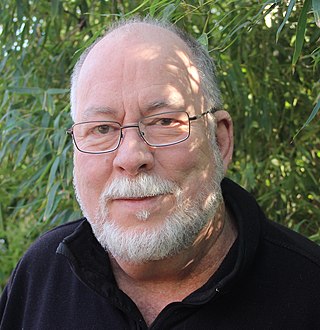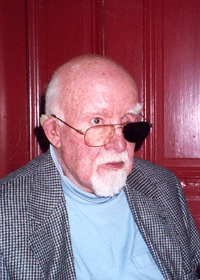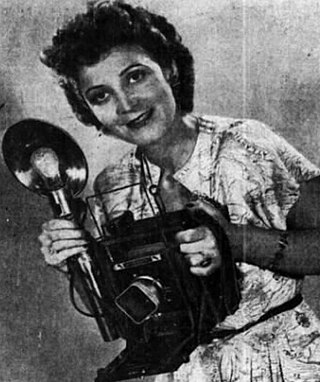Related Research Articles

David Cherry is an American artist, author, and illustrator of science fiction and fantasy and has also done substantial work as a marketing artist, concept artist, and 3D modeler in the game production industry. Cherry served as Lecturer and Head of the Art Department as well as Head of the master's degree Program for artists at The Guildhall at SMU, a graduate college dedicated to studies for people who want to work in the game production industry. Cherry was also an attorney, as well as a past president of the Association of Science Fiction and Fantasy Artists (1988–1990). He has been nominated eleven times for Hugo Awards, and 18 times for Chesley Awards.

Ralph Angus McQuarrie was an American conceptual designer who worked in film and television. His career included work on the original Star Wars trilogy, the original Battlestar Galactica television series, the film E.T. the Extra-Terrestrial, and the film Cocoon, for which he won an Academy Award.
Concept art is a form of visual art used to convey an idea for use in films, video games, animation, comic books, television shows, or other media before it is put into the final product. Concept art usually refers to world-building artwork used to inspire the development of media products, and is not the same as visual development art, though they are often confused.

John Carl Schoenherr was an American illustrator. He won the 1988 Caldecott Medal for U.S. children's book illustration, recognizing Owl Moon by Jane Yolen, which recounts the story of the first time a father takes his youngest child on a traditional outing to spot an owl. He was posthumously inducted by the Science Fiction and Fantasy Hall of Fame in 2015.

A matte painting is a painted representation of a landscape, set, or distant location that allows filmmakers to create the illusion of an environment that is not present at the filming location. Historically, matte painters and film technicians have used various techniques to combine a matte-painted image with live-action footage (compositing). At its best, depending on the skill levels of the artists and technicians, the effect is seamless and creates environments that would otherwise be impossible or expensive to film. In the scenes, the painting part is static while movements are integrated on it.

Barbara Nessim is an American artist, illustrator, and educator.

John Berkey was an American artist known for his space and science fiction themed works. Some of Berkey's best-known work includes much of the original poster art for the Star Wars trilogy, the poster for the 1976 remake of King Kong and also the "Old Elvis Stamp".
Mattes are used in photography and special effects filmmaking to combine two or more image elements into a single, final image. Usually, mattes are used to combine a foreground image with a background image. In this case, the matte is the background painting. In film and stage, mattes can be physically huge sections of painted canvas, portraying large scenic expanses of landscapes.

Bob Eggleton is an American science fiction, fantasy and horror artist. Eggleton is a nine-time Hugo Award–winner for Best Pro Artist in science fiction and fantasy, first winning in 1994. He won the Hugo Award for Best Related Book in 2001 for his art book Greetings from Earth. He also won the Chesley Award for Artistic Achievement in 1999 and was the guest of honor at Chicon 2000.
Craig Mullins is an American digital painter, and leading international concept artist. He has created art for books, video games and films. He is often considered to be a pioneer in the field of digital painting, painting digitally for many years before drawing tablets were available.

Jack Banham Coggins was an artist, author, and illustrator. He is known in the United States for his oil paintings, which focused predominantly on marine subjects. He is also known for his books on space travel, which were both authored and illustrated by Coggins. Besides his own works, Coggins also provided illustrations for advertisements and magazine covers and articles.

Randy "rk" Post is an illustrator of fantasy publications.
Gene Szafran was an American artist, illustrator, and sculptor. He was known for illustrations in magazines including Playboy and Fortune and cover art for science fiction books published by Bantam and Ballantine during the 1960s to 1980s, including a series of Signet paperbacks of Robert A. Heinlein's work.
David Edward Byrd is an American graphic artist, designer, illustrator and painter. Many of his designs are considered to have helped define the look of rock and roll music starting in the 1960s. He is most well known for his poster designs, including his rock posters for the Fillmore East as well as his Broadway theatre posters.
Gervasio Gallardo is a Spanish artist and illustrator. He has produced numerous of surreal paintings and book covers, for many science-fiction and fantasy authors.
Rick Berry is a contemporary American expressionistic figure artist based in the Boston area. Berry creates art for galleries, illustration, and paintings for theatrical performances. Berry's work has appeared in many science fiction, fantasy and comic books, including Neil Gaiman's Sandman, Magic: The Gathering cards, and Stephen King novels. In 1985, Berry created the first digitally painted book cover worldwide for William Gibson's Neuromancer. Berry has also written under the names Sam Rakeland, R.R. Berry, Rich Berry, Richard Berry, and O. Berry.
Michael Pangrazio is an American art director in the feature film industry best known for his matte painting work on Raiders of the Lost Ark and The Empire Strikes Back. As traditional and digital matte artist, he created some of the most famous matte paintings in movie history. His best known painting is the Raiders of the Lost Ark warehouse interior set-extension at the end of the movie.
Wayne Haag is an Australian artist and illustrator, mainly of science fiction works.
Henry Richard Van Dongen, often professionally known as H.R. Van Dongen, was an American artist best known for his science fiction magazine and book covers.

Adelaide Leavy later worked as Addie Passen was a pioneering American photojournalist and one of the few women photographers who participated in sports photography beginning in the 1940s. She was one of the first women admitted to the National Press Photographers Association in 1945. Transitioning to studio work, she worked with cosmetic firms, models, and developed a reputation doing reference photographs for illustrators.
References
- ↑ "Summary Bibliography: David B. Mattingly". ISFDB. Retrieved August 4, 2016.
- 1 2 3 Mattingly, David B. (2011). The Digital Matte Painting Handbook. John Wiley & Sons. ISBN 9781118078044 – via Google Books.
- 1 2 "Pratt Institute".
- ↑ "David Mattingly - MFACA". Archived from the original on 2015-03-25.
- ↑ "David Mattingly". IMDb .
- ↑ Cathleen Cogswell. Alternate views, alternate universes: the art of David B. Mattingly. Paper Tiger. 1996
- 1 2 "Meet the Artist Behind the Animorphs Covers That Destroyed Your Mind as a Kid - VICE - United States". 7 December 2015.
- ↑ "Artist Guest of Honor: David B. Mattingly". Technicon 24. Archived from the original on July 28, 2011. Retrieved November 30, 2010.
- ↑ "Wiley: The Digital Matte Painting Handbook". Sybex Books. Archived from the original on August 20, 2016. Retrieved August 4, 2016.